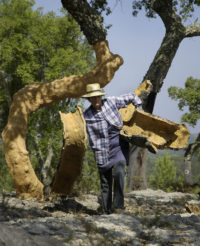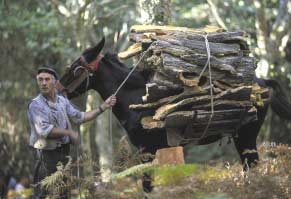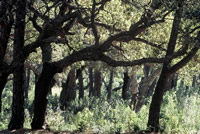Overview
The Southern Portugal Green Belt project was undertaken as part of the larger WWF Mediterranean Cork Oak Landscapes Programme to restore the cork oak forest landscape at two pilot sites in Southern Portugal. Spanning the Portuguese provinces of Alentejo and Algarve in an area of exceptional natural value extending 8,000 km2, the restoration targeted cork oak forests belonging to the warm and humid mixed-oak forest type–dominated by cork-oak (Quercus suber). The project aims to increase forest surface and improve the structure and density of forest habitats through tree/shrub production and plantation and effective long-term management practices. This will facilitate the natural regeneration of the cork forest stands and ensure sustainable livelihoods for local community members while protecting the region’s biodiversity.
Quick Facts
Project Location:
37.8061776, -7.6789051
Geographic Region:
Europe
Country or Territory:
Portugal
Biome:
Temperate Forest
Ecosystem:
Temperate Forest - Mixed
Area being restored:
28.5 hectares
Project Lead:
WWF Mediterranean Cork Oak Landscapes Programme
Organization Type:
NGO / Nonprofit Organization
Location
Project Stage:
Completed
Start Date:
2004-03-26
End Date:
2005-02-26
Primary Causes of Degradation
Agriculture & Livestock, Urbanization, Transportation & IndustryDegradation Description
The health and longevity of cork oak forests is heavily dependent upon management practices revolving around the manufacture of cork bottle stoppers to supply the wine industry. Unfortunately concerns about tainted corks in recent years have helped increase the popularity of synthetic stoppers (i.e. plastic and metal screw tops), and it is estimated that between 2000 and 2005, cork-stopper sales fell worldwide by nearly 20 percent. Portugal, in particular, has seen a considerable decline in cork-stopper exports to Australia and the US. The resulting devaluation of cork oak forests has meant less incentive to effectively manage and preserve them and growing threats from fires, disease, overgrazing and conversion for agricultural production.
Reference Ecosystem Description
Cork oak habitats have been ranked among the most valuable habitats in Europe and have been listed in the EC Habitats Directive. Not only are they a vital source of income for thousands of people, they support one of the world’s highest levels of forest habitat biodiversity. Plant diversity can reach as high as 135 species per square metre–many of these having aromatic, culinary or medicinal value–and a high degree of endemism occurs in these floral communities. Undergrowth is thick with heathers, leguminous plants, rock roses and herbs, and more than 30 different brackens are found here.
In addition to their rich and varied flora, cork oak forests also support tremendous faunal diversity that includes: spiders, spadefoot toads, geckos, skinks, vipers, mongoose, roe deer, boars, genets and a plethora of avian species. Wintering birds from northern Europe, including virtually the entire common crane population, arrive by the millions to find shelter in the cork oak landscapes of the Mediterranean, and storks, kites, vultures, buzzards, booted eagles and short-toed eagles also congregate here.
Cork oak landscapes also provide important habitat for several threatened and endangered species. The Iberian lynx is the most endangered cat in the world, with only an estimated 100 individuals left, and cork oak forests are one of the habitats that afford it food, shelter and breeding grounds. The Spanish Imperial eagle, one of the world’s four most endangered birds of prey (represented by only 150 breeding pairs), is also a regular inhabitant of these forests.
Project Goals
To develop ecological restoration guidelines for cork oak forests and promote management techniques that reconcile nature conservation and natural resources management.
Monitoring
The project does not have a monitoring plan.
Stakeholders
A number of important stakeholders support the Southern Portugal Green Belt project and are now collaborating in its implementation. Partnerships have been formed between WWF, the regional Algarve reforestation commission, the farmers’ association of Monchique, the CBA-FFUL research institution, and local NGOs. In addition to organizing field visits and presentations for local farmers, the project has included training workshops to disseminate restoration methodology and forest management techniques to a variety of participants. For instance, in November 2004, a one-day applied workshop on tree nursery production techniques for native species from cork oak forests was organized by WWF in Mertola; and NGOs, landowners and foresters involved in the WWF cork oak forest projects in Portugal, Tunisia and Morocco were invited to attend. As a follow-up to the workshop, a two-day field visit through the green belt area was organized to share project experiences, restoration results at the 2 project sites (Monte de Vento and Herdade da Ribeira Abaixo), and information about other sites where restoration is foreseen (e.g. Monchique and Cladeirao). It is hoped that the involvement of these key stakeholders, and the participation of local farmers, will help generate needed resources and expand the restoration effort.
Description of Project Activities:
Restoration of the cork oak landscape was undertaken at two pilot sites. The first, Herdade da Ribeira Abaixo, is a 221-ha farm located in the Cercal/Grandola Natura 2000 site and owned by the Portuguese Ministry of Agriculture. This farm is managed by the Centre for Environmental Biology (CBA) Research Station of the University of Lisbon. The second site is Monte do Vento, located in the Guadiana Valley Natural Park and owned by the Associaúão de Defesa do Património de Mértola (ADPM), a local NGO. This site consists of 198 ha of holm oak and cork oak woodlands.
Acorns were collected in Monte do Vento and Herdade da Ribeira Abaixo at the beginning of January 2004. Seven thousand acorns were planted in the Monte do Vento tree nursery (owned and run by the ADM) between January and February 2004 for later use at the 2 sites. In addition, during the period March to May 2004, 3,000 native plants (Arbutus Unedo, Cercis siliquastrum, Punica granatum and Fraxinus angustifolia) were produced in the tree nursery to increase biodiversity in the restoration areas. Moreover, between December 2004 and February 2005, 15,000 native plants of various species were prepared for the restoration work to be undertaken in 2005 after the closure of the project funded by the Nando Peretti Foundation.
Based on the detailed methodology and restoration plan developed, fieldwork was executed on 13 ha at Monte do Vento and on 15.5 ha at Herdade da Ribeira Abaixo. Work began in May 2004 with the preparation and cleaning of the project sites. At HRA, this preparation included the selective removal of invasive species in July 2004. Project executants were contracted in September 2004, and vegetation control and soil mobilization activities took place in November. Cork oak saplings were planted in November 2004, along with other nursery-reared species, and the saplings were inoculated with fungi to improve plant health and soil structure.
Ecological Outcomes Achieved
Eliminate existing threats to the ecosystem:
A total of 25,000 plants (including: Quercus suber, Q. faginea, Fraxinus spp., Arbutus unedo) were produced by the tree nursery. 4,500 saplings were planted at Monte do Vento in November 2004, and 10,000 saplings were planted at HRA in November 2004.
Factors limiting recovery of the ecosystem:
Drought in winter and high temperatures in summer damaged many of the saplings at Monte do Vento. The Monte do Vento team will be following up with continued actions (i.e. planting during spring and autumn) and maintenance.
Socio-Economic & Community Outcomes Achieved
Economic vitality and local livelihoods:
In addition to cork production, the cork oak forest landscapes provide an important range of non-timber forest products--especially pasture for livestock, honey, mushrooms, acorns, berries, medicinal and aromatic plants, and game. These products are of considerable importance in national and international markets and contribute substantially to livelihoods in the rural economy. Valuable environmental services, such as soil conservation, water protection, carbon sequestration and biodiversity conservation, are also provided by cork oak landscapes.
Key Lessons Learned
This was a successful pilot project producing achievements that can be developed and built upon. The project team has developed proposals for fundraising to continue the work at the two sites (i.e. monitoring & maintenance of field work), and in addition, the success of the project has led to an expansion of the restoration strategy into other areas of the Green Belt. Support for these initiatives has been obtained from the Algarve reforestation commission, and a new project is planned for Monchique (a burnt area) that will be conducted in partnership with the Monchqiue landowners cooperative, Pulp companies like Celbi and Portucel, and the local NGO Vicentina. WWF is also in discussion with LPN (an NGO active in the Caldeirao region that is currently implementing a project to protect the Iberian Lynx) in hopes of developing a strategy for restoring vital habitat for the Lynx.
Long-Term Management
Under the auspices of its Cork Oak Landscapes Programme, which aims to protect, manage and restore cork oak landscapes in the Southwestern Mediterranean, WWF will ensure the sustainability of results produced by this pilot project and will continue to disseminate these results, via its partners in Portugal, throughout the Mediterranean and beyond. In addition to project activities implemented during this 1-year pilot project, WWF and local partners have invested much energy in securing funding for the expansion of restoration work into other at-risk sites (e.g. Monchique and Caldeirao).
In fact, during a press conference at HRA in November 2004, the reforestation commission officially agreed to fund a restoration project in Monchique. The project was scheduled to begin in June 2005 and, like the pilot project, will involve many local stakeholders.
A pilot restoration plan for Caldeirao was also under discussion with other parties involved in nature conservation (i.e. The Iberian Lynx Project managed by the Portuguese NGO LPN) and was to be undertaken in association with current development projects in this Natura 2000 site (i.e. the cork oak forest management project led by the local NGO In Loco).
Sources and Amounts of Funding
Funding for the Herdade da Ribeira Abaixo and Monte do Vento projects has been secured through the Cork Oak Landscapes Programme of the World Wildlife Fund, as well as local funding programmes. The Nando Peretti Foundation provided funding for the pilot restoration projects conducted in 2004 at the Herdade da Ribeira Abaixo and Monte do Vento sites, and funding for continuing work in 2005 and 2006 was to be provided by the European Commission AGRO and RURIS programmes.
The Monchique pilot restoration plan has secured funding for 2005 through WWF and the FEDER programme. The Algarve Regional Forestry Commission (Ministry of Agriculture) has committed to co-fund 75% of the WWF pilot restoration work in Monchique for 2005 and 2006.
Other Resources
Xavier Escute
Cork Oak Capacity Building Officer
WWF Mediterranean
[email protected]
Luis Neves Silva
Potuguese Forest Officer
WWF Mediterranean
[email protected]
World Wildlife Fund — Cork Oak Landscapes Programme
http://www.panda.org/about_wwf/where_we_work/europe/what_we_do/mediterranean/about/forests/cork/index.cfm




